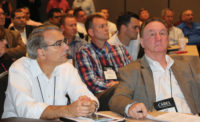The IoT is revolutionizing the way people live and work, and nowhere is that more apparent than in supermarkets around the country. Grocery store owners and managers are increasingly utilizing the IoT in order to monitor the performance of their refrigeration equipment, so they can take immediate action should a problem arise.
Having that capability to head off potential problems is extremely important because unplanned downtime can be very costly for end users, said Ron Chapek, director of product management, ProAct Enterprise Software Services, Emerson.
“With the IoT, they have the knowledge to make quick repairs and prevent future errors, which means less lost revenue, less lost inventory, and ultimately helps ensure food safety,” he said.
BIG IMPACT
The IoT offers tremendous benefits to both refrigeration contractors and supermarket owners and managers.
For the latter, it allows better insights into how their facility is running through the use of connected devices and data analytics. This information enables managers to take proactive measures that help maximize energy efficiencies and cost savings while optimizing food safety, said Richard Ruth, product manager - services, Danfoss.
“With IoT-integrated controls, a chain owner and contractor can also compare operations at various sites and take advantage of learning and performance at each location to optimize the entire portfolio,” said Ruth. “These technologies allow the tracking of actual results of upgrades and retrofits to help justify and advance energy- and cost-saving upgrades.”
Owners and contractors alike also appreciate the preventive maintenance and predictive failure alerts that are usually part of an IoT solution. So instead of performing preventive maintenance on a fixed schedule, such as every six months, it can be triggered by real system performance, explained Paul Mullin, chief engineer of software climate solutions, Regal.
“An IoT solution monitors a system’s performance and helps its maintenance team decide when to take action,” said Mullin. “For example, if there is a clogged filter in a unit, how much extra is it costing the business per day, compared to the cost to send a technician out to clean the filter? Instead of sending technicians there every six months, it is possible to deploy them when it makes the most financial sense for the business.”
Indeed, predictive maintenance is one of the main benefits of the IoT, as connected sensors can provide real-time insights into the health of the refrigeration equipment, so critical maintenance can be performed before failures occur. Sensors can also help identify spikes in energy use, as well as increased vibration and excessive noise — all telltale signs that a compressor could be on the verge of breaking down, said Karin Vogel, head of marketing, Electric Imp.
“With this knowledge in hand, maintenance can be scheduled and conducted prior to failure, preventing costly downtime and eliminating the need for expensive emergency service calls,” she said.
The IoT can also help fill the void left by the growing number of aging contractors and technicians who are retiring and leaving the business. These individuals have a lot of intellectual property that new contractors and technicians do not have. Yet the newcomers are expected to install and repair equipment correctly and quickly, explained Chapek, because when not done properly or efficiently, installation and repair drive up both cost and risk exponentially for end users.
“The IoT provides a plug-and-play capability that greatly helps overcome the challenge the industry faces when losing the intellectual property that the aging contractor base possesses,” said Chapek. “With the abilities to collect and store all this information, contractors will no longer have to rely on intelligence to be passed down from other contractors who are approaching retirement.”
PROPER IMPLEMENTATION
Before implementing any IoT solution, contractors must first understand their customers’ goals. For example, if a business wants to reduce maintenance costs, understanding exactly how that will happen is important, explained Mullin.
“Will they dispatch service personnel from a central location to prevent significant travel costs? Or, is the first-line serviceperson on-site? The financial benefits for IoT can be quite different in the two scenarios, making the cost of the IoT solution a primary concern,” he said.
On the other hand, if a customer is more interested in measuring the real-world performance of equipment to influence their buying, the accuracy and scope of the data collected becomes more important, said Mullin.
“If we are to compare the efficiency of two units, then we must be sure to collect accurate internal and external environmental data for each situation,” he said. “The IoT solution to accomplish this will be more extensive than one intended to reduce maintenance costs.”
Contractors also need to find out if their customer requires a stationary or mobile IoT solution, or one that supports both. This is very important because cellular connectivity can be expensive and complex to set up, so if this option is required, contractors need to recommend a solution that addresses the cost and complexity, said Vogel.
Another significant consideration is whether electricity is readily available to power the connected devices or if any of the devices will rely on batteries. If battery power is required, contractors will need to verify that the IoT solution is extremely energy efficient and maximizes battery life, noted Vogel.
“This is important, as regularly swapping out the batteries on a device on board a constantly moving refrigerated trailer can be difficult,” she said. “Additionally, the labor and fuel costs of regularly servicing individual freezers in far-off locations adds up quickly.”
There are also big risks involved if an IoT solution is improperly implemented, as its benefits can quickly be negated and security can become compromised. That is why contractors need to be aware of the widely varying differences among the values delivered by IoT devices. As Chapek noted, the best devices are plug-and-play and self-diagnosing because they are easy to install and can be remotely reprogrammed, instead of requiring polling, which can be inefficient.
Of course, proper security throughout the system — including in the sensors, transmission hardware, the cloud, and all system software — should be a huge design consideration, noted Mullin. Security includes not only preventing hackers from stealing data, but also ensuring the data is authentic, which is why he recommends checking for these features in any IoT solution:
- Data transmitted wirelessly should be encrypted;
- Devices must use a secure method to join the network (some sort of key exchange) under the control of the user to prevent rogue devices from joining;
- Networks should have rolling keys so that each location is keyed differently and no key lasts more than a few days; and
- All levels of the system (gateways, routers, and sensors) should receive software updates over the air, as it is essential that a quick method is available to push security updates if weaknesses are exposed.
In order to provide their customers with the correct IoT solution that is also secure, contractors should consider partnering with a manufacturer that offers expertise in this area. For example, Emerson can consult with end users to help identify the actions that will save the most money while effectively helping to prevent inventory loss and reduce risks, such as food safety. In addition, they can help identify the steps that need to be taken for corrective action and help technicians fix the problems quickly and correctly the first time.
“When implementing an IoT solution, there is more to simply collecting the data,” said Chapek. “When contractors can facilitate the discussion on the importance of data dissemination, it will lead to a more successful adoption of the solution.”
Successful implementation also includes making sure that the solution is properly integrated and connected during the commissioning phase, said Ruth, as this ensures that all parameters and functions are tested and operating in accordance with the specifications and operating practices.
“The connected and monitored functions of these systems will ensure that the conditions that exist during commissioning will be maintained throughout the life of the store,” said Ruth. “In addition, as the store changes and its outdoor environment fluctuates, these technologies allow for all operations to be optimized and adjusted as needed, often without the necessity of a service call. Functionalities such as predictive maintenance and alarm monitoring can also make certain that refrigeration temperature integrity is maintained and services are coordinated to minimize food waste and save emergency service costs.”
HERE TO STAY
— Ron Chapek, director of product management, ProAct Enterprise Software Services, Emerson
There is no question that data gathered from a vast number of refrigeration systems running in the real world will make an impact on the industry. For example, Energy Star ratings could eventually be awarded based on a design’s actual performance in the application instead of in laboratory tests, said Mullin. And owners purchasing a piece of equipment with specific ratings will know if those ratings are achieved.
Immediate and accurate data from the field will also likely drive changes in the design and use of commercial refrigeration equipment, added Mullin.
“It is uncertain what those changes will be, but they will certainly improve performance and reduce the global impacts of commercial refrigeration,” he said.
Chapek agrees that as more refrigeration equipment and devices become connected, the increased amount of information available through the IoT will allow a better understanding of how equipment is operating.
“The impact over the next five to 10 years will come from adding intelligence and pulling more meaningful data,” he said. “It will become increasingly important to filter all the data that can be realized from the IoT and push intelligence to the edge. It will also be important to be able to contextualize that data, provide smart interpretation, and enable predictive maintenance and analysis. This will help reduce risk and maintenance costs and decrease equipment downtime even further.”
As more supermarket owners and managers seek to maximize both equipment life and investments, advancements can also be made in IoT development that can allow devices to connect to legacy equipment, allowing information to be pulled from systems that are not optimized, predicts Chapek. This will allow legacy equipment — and its owners — to fully participate in the era of the IoT.
Publication date: 9/3/2018
Want more HVAC industry news and information? Join The NEWS on Facebook, Twitter, and LinkedIn today!






Report Abusive Comment